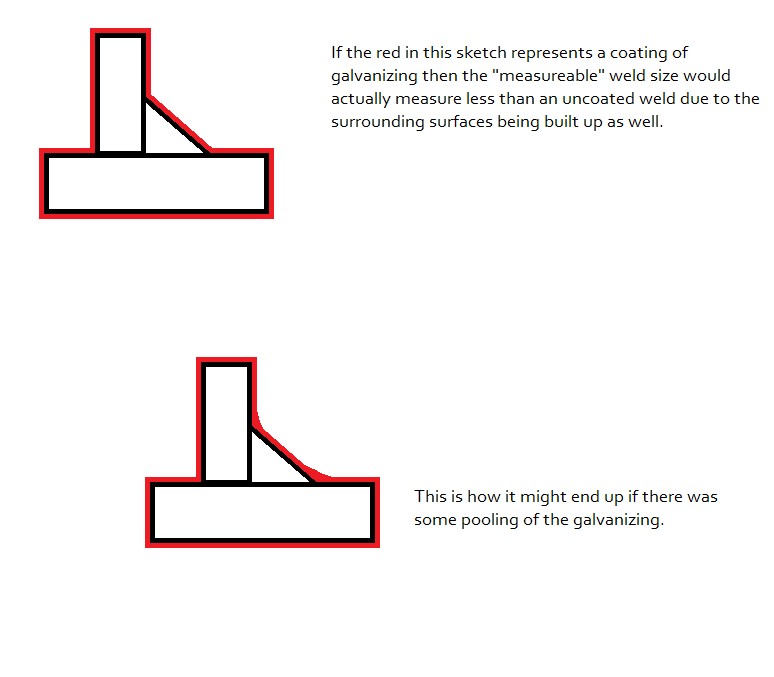Yes. Brent, with your experience you're the go-to guy to be giving advice on this one and I defer to your judgement. Definitely not disagreeing with you. All of our galvanized parts are coated to only a few mils but I can see large structural shapes behaving much differently than the components I've been inspecting lately. My input was based on theory and not practical experience.
With 1/16" of build-up on the weld I wouldn't even attempt to size them.
I agree completely that the weld sizing should not even be considered AFTER galvanizing. Why would it even be in the specs?
Again, it all depends upon how parts are hanging, dipped, cured, and then if the weld is concave or convex, etc. Even using Allan's diagrams it would not be inconceivable to have a concave fillet weld with puddled galv enlarging the dimensions so that the throat was able to be measured much larger since the gauge sits back from the corner being measured. Galv settles into the low area while being removed from the tank.
What I found hard to believe is that HDG is only .79mil thick. Less than .00080 in thickness? Really? (honest question, not rhetorical nor sarcastic) If my simple math is correct, 1 mil is .001 or 1 thousandth of an inch as I recall. So .79 mil is just over 3/4 of 1 mil or .001 which means in decimal equivalents it should be about .00079. That seems awfully thin to me for what I normally see for Hot Dip Galv.
1/64"= about 15 mil = .015625.
Anodizing or paint I could see, but galvanizing by Hot Dip? Is there really supposed to be a decimal in front of the 79?
Now remember, most of my experience with HDG is with channels, angles, flat bar, beams, weldments with differing angles, pipe/tube, etc. Maybe they aren't that careful about the thickness on these as on other applications; bolts/nuts, machined parts, etc.
But, bottom line is, when should the weld sizing have taken place. NOT after the galvanizing seems to be the common consensus and the code application per clauses already cited.
Lawrence, I don't consider you rude. Even when we disagree. Your sentence structure and word choice caught me off guard. I was challenged once when I used 'incredulous' as to if I knew what I had just said. While there can be variations of most of our words it still came down to 'unwilling or unable to believe something'. I still use it at times when a better word or at least a change in the sentence/paragraph structure would be most advantageous.
Still your respected friend, Brent
edit: dyslexic moment; .76 not .79
Hello Brent and others, I have been around galvanizing on a number of fronts and for a number of years. When I was located in the Portland, Ore. area I believe that there were 3 major galvanizers that the locals used for their parts/structures/etc. There are so many variables that can add to or subtract from the "coating" that results from the dipping process.
Vat temperatures, how parts are positioned and whether they are shifted during the dipping process and when as related to their removal. How clean the parts were and how they were cleaned prior to dipping and more. How the parts are removed and where and how they are oriented upon removal for "cool down". Just about everyone of these galvanizers would exhibit somewhat different results when you viewed the various parts.
I don't know for sure if In Tension may have been referring to zinc plating when he made comments about the thicknesses of deposited by galvanizing, I do believe that even though these two processes accomplish roughly the same purpose they are definitely different in how they are applied. Personally I have been around the hot-dip galvanizing quite a bit and have never been directly exposed to the zinc plating process that is often used on many fasteners. But, the zinc plated fasteners generally do have a very "thin" coating when compared to the more industrial zinc coatings that result from the hot-dip processes used on them.
Bottom line here: any inspection of the "welding" should have occurred prior to coating, then if there is a provision for knowing the coating thicknesses(as there sometimes are) the appropriate equipment should have been employed after coating for verification.
Great thread folks and very informational, you all got my grey-matter to percolating. Best regards, Allan



